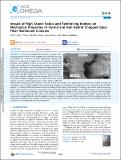Please use this identifier to cite or link to this item:
http://hdl.handle.net/11547/11560| Title: | Impact of High Aspect Ratios and Reinforcing Indexes on Mechanical Properties of Hybrid and Non-Hybrid Chopped Glass Fiber Reinforced Concrete |
| Authors: | Cakir, Ferit |
| Keywords: | FRACTURE-BEHAVIOR BASALT |
| Issue Date: | 2022 |
| Series/Report no.: | 7;50 |
| Abstract: | Due to technological advancements, concrete can be currently produced with varying strengths and durability based on its intended use. However, in many applications, concrete still needs to be improved in terms of its mechanical and physical properties. The addition of fibers to concrete is one of the most widely used methods for improving its mechanical and physical properties. The study focuses on the effects of the high aspect ratios and reinforcing indexes on the mechanical properties of the hybrid and non-hybrid chopped glass fiber reinforced concrete (CGFRC). In this study, the glass chopped fibers (GCFs) (fiber diameter, 4 = 0.015 mm) with four different volume fractions (0, 0.5, 0.75, and 1%) and four different lengths (3, 6, 12, and 24 mm) were mixed into the concrete considering the aspect ratios between 200 and 2800 and the reinforcing indexes between 1 and 42. A total of 51 samples were prepared for the study that included 3 control, 36 non-hybrid, and 12 hybrid samples. Then, the flexural strength and compressive strength tests were conducted on the CGFRC samples. To obtain detailed information about fiber pullout, fiber breakage, debonding, or cracking in the matrix, digital microscopy and scanning electron microscopy examinations were performed. The flexural strength of the hybrid samples increased with the higher aspect ratios and reinforcing index values, whereas the flexural strength of non-hybrid samples decreased with the higher aspect ratios and reinforcing index values in the CGFRCs. Moreover, all non-hybrid and hybrid CGFRC samples had lower compressive strengths than the control samples in terms of compressive strength. With an increase in the fiber volume fraction, the mixing and workability of the samples considerably decrease, and the increase of the fiber volume fraction caused brittle fractures in concretes to be transformed into ductile fractures. |
| URI: | http://hdl.handle.net/11547/11560 |
| ISSN: | 2470-1343 |
| Appears in Collections: | Web Of Science |
Files in This Item:
| File | Description | Size | Format | |
|---|---|---|---|---|
| cakir-et-al-2022-impact-of-high-aspect-ratios-and-reinforcing-indexes-on-mechanical-properties-of-hybrid-and-non-hybrid.pdf | 3.13 MB | Adobe PDF |  View/Open |
Items in DSpace are protected by copyright, with all rights reserved, unless otherwise indicated.
